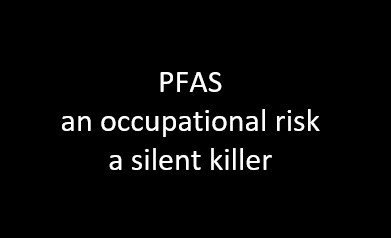PFAS (per – poly fluoro alkyl substances) are man-made chemicals, almost 15,000 of them, used in industry and consumer products since 1950s.
PFOA (per fluoro octanoic acid) and PFOS (per fluoro octane sulfonate) are the two most common PFAS.
In 2009, a study by ATSDR (Agency for Toxic Substances and Disease Registry) found that people who work where PFAS is manufactured have much higher levels of it in their blood compared to those from the same area who did not work where PFAS were manufactured.
PFAS may be a silent killer, and sooner we realize the better it is to prevent a lot of diseases.
PFAS are valued for their inherent properties, namely, resistance to heat, water and oil. This makes PFAS a useful chemical to be used in industrial and consumer products like apparel, carpet, upholstery, cosmetics, fire-fighting foams, food packaging, metal plating etc.
Being bio-accumulative (they accumulate in blood and tissues), PFAS pose a health problem that came to the fore when research in the 1980s found links between the 2 commonly used PFAS (PFOS and PFOA). Thyroid issues, kidney disorders, decreased birth weight and some types of cancers were linked to PFAS. Research is being done since then by EPA and others to determine the health effects for thousands of PFAS which are used in industrial and consumer products.
Making the office healthier can be a part of wellness initiative as well and sessions to create awareness about dangers of PFAS and encouraging the employees to identify it in fabrics and other objects in their homes will help reduce PFAS levels.
The CDC (Centers for Disease Control) and ATSDR (Agency for Toxic Substances and Disease Registry) have updated their clinical recommendations for PFAS testing. The guidance states that ‘testing may help some individuals understand if they are exposed to certain PFAS and help guide exposure reduction.’ The guidance provides information to help doctors weight the benefits and risks of PFAS blood testing based on patient’s exposure. The agency also stated that ‘PFAS blood test will not provide information to pinpoint a health problem and will not predict future health outcomes.’
Meanwhile, NASEM (National Academies of Sciences, Engineering and Medicine) report suggested that if physicians find higher blood levels of PFAS they prioritize screening for lipids, thyroid and kidney cancer. The CDC, however, hasn’t adopted these guidelines.
EPA (Environmental Protection Agency) of USA has prioritized industries for attention in its efforts to regulate and remediate PFAS. The EPA is using the rulemaking authority granted to the agency by the Congress to monitor PFAS industrial usage and discharge.
Rulemaking for industries on which EPA has data: These are industries involved in organic chemicals, plastics, synthetic fibers, metal finishing and electroplating.
Industries targeted for more study: Electrical and electrical components, textile mills and landfills are in this category.
Industries targeted for PFAS data review: These include leather tanning and finishing, plastic molding and forming, paint formulating.
Industries targeted for PFAS monitoring: Airports, paperboard and pulp & paper.
Workers get exposed to PFAS via inhalation, ingestion, skin and the eyes.
The prevention and immediate action in case of exposure are briefly enumerated below:
Inhalation: Exposure by inhalation can be prevented by having robust local exhaust systems and use of respirators. Unexplained coughing and sore throat near PFAS manufacturing may be symptoms of PFAS inhalation. Workers exhibiting such symptoms should be administered fresh air and referred for medical opinion.
Skin exposure: It can be prevented by wearing protective gloves. Redness and pain indicate skin exposure. In such a case, any contaminated clothing should be removed immediately and exposed skin should be rinsed and thereafter cleaned with water and soap.
Eye exposure: Exposure to PFAS to eyes is prevented by use of safety goggles preferably with breathing protection. Workers exposed to PFAS may complain of pain, redness and blurring of vision. The first-aid is to immediately rinse the eyes with plenty of clean water and then seek medical attention. The contact lens, if worn, must be removed before rinsing.
Ingestion: To prevent exposure by ingestion do not eat, drink or smoke around the area of manufacture of PSAS. Abdominal pain, nausea and vomiting are some of the symptoms if PFAS ingested. In case of workers who ingest PFAS rinsing of mouth, drinking plenty of water and seeking medical attention is advocated.
Some of the PFAS (example, PFOA) are corrosive and so should be stored separately. In case of PFAS spill, workers should wear a P2 filter respirator and moisten the spill to prevent dust cloud which could be inhaled. The spilled PFAS should be collected in non-metallic containers and kept covered.
Day-to-day ways of lowering your PFAS exposure is important as it is everywhere. For example, PFAS can be ingested just by placing a rug on a heated floor or eating from a fast-food container. Avoiding these may help.
As a MSME (Micro Small Medium Enterprises) business owner having no access to Occupational Health physician, the office can be made healthier by identifying PFAS containing fabrics and other items and taking steps as above to reduce exposure to PFAS and subsequent health risks to employees as well as themselves. After all the business owners also spend time in their office premises.
In fact, some researchers say that healthier (devoid of PFAS) furnishing and carpet should be manufactured. They also said manufacturers should also provide chemical lists for these healthier materials that are verified by an outside source. Having homes and offices with healthier furnishings could reduce exposure to PFAS.
The EPA recommends testing drinking water samples.
Since PFAS harms the liver, cutting down on alcohol could reduce some damage to the liver. Eating a balanced diet having lots of vegetables and avoiding ultra-processed foods could help neutralize some increase in lipids that could be due to PFAS.
As an OH physician, a proactive step would be to create awareness among employees many of the harmful effects of PFAS could be reduced if one could eat healthy foods, avoid alcohol etc. In addition, if the employee works or lives close to a PFAS manufacturing facility periodic screening of target organs (like liver, kidney, prostate etc.) be done.
MSME (Micro Small Medium Enterprises) business owners who have no access to Occupational Health physician can make the office healthier by identifying PFAS containing fabrics and other items and taking steps as above to reduce exposure to PFAS and subsequent health risks to employees as well as themselves. After all the business owners also spend time in their office premises. The business owners can spread the awareness to all their employees who can take the message home.
In large offices that have access to OH physician, similar steps must be taken along with admin teams to create a healthy office by reducing PFAS to ALARP (as low as reasonably practicable).
Making the office healthier can be a part of wellness initiative as well and sessions to create awareness about dangers of PFAS and encouraging the employees to identify it in fabrics and other objects in their homes will help reduce PFAS levels to ALARP. This will benefit the health of the entire family with future health issues.
PFAS is an example where it is not the work or the working condition but the workplace that is impacting health of the worker or the inhabitants in a room due to a chemical substance. PFAS may be a silent killer, and sooner we realize the better it is to prevent a lot of diseases.
The employees can be further reassured that PFAS have been in use since 1950s and though research says there is danger to health, however, it is not an immediate threat as research is ongoing. As and when research as well as statutory bodies change guidelines they would be aptly implemented. The current conclusions by International Agency for Research on Cancer (IARC) and EPA of USA are that PFAS are possibly carcinogenic.
Stringent guidelines have been made in the developed countries while the developing and underdeveloped countries have to make progress in making and implementing the guidelines. In addition, regulatory compliances along with exposure assessment and risk characterization is crucial to provide precautionary advice on water source protection, water supply security, health risks, treatment efficiency and contamination forecating,
Intense monitoring and testing are required both in environment and humans. For example, Ghana does not manufacture PFAS but imports to make industrial and consumer products. Lack of guidelines and regulatory compliances has led to improper disposal of PFAS thereby contaminating surface water in Ghana.
To know more, contact
____________________________________________________________________________________________
Dr Ajay Sati is an Occupational Health physician who prefers to describe himself as an Occupationist, to denote, ‘an expert in diseases and other concerns of occupations.’ Dr Sati has managed health and wellness programs in industries he worked, like the atomic energy, and energy (oil & gas) in India and overseas. An experienced virtual consultation expert he was involved in many greenfield and brownfield projects providing inputs from health point of view.



